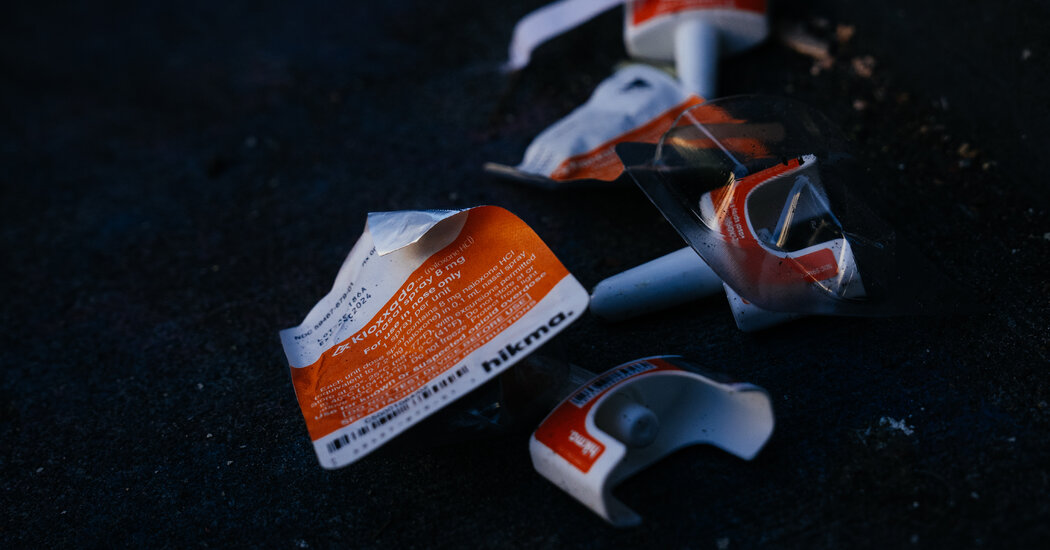
Overdose deaths in the United States fell slightly last year, the first decline in five years, according to preliminary federal data released Wednesday.
The rare good news in the decades-long addiction crisis is attributable mostly to a decline in deaths from synthetic opioids, mainly fentanyl, said researchers at the National Center for Health Statistics, who compiled the numbers.
But the full picture of the drug death toll remains bleak. Although deaths from opioids have decreased, deaths from stimulants such as cocaine and methamphetamine have increased. And some states, including Oregon and Washington, continued to see sharp increases in overall overdose deaths.
Overall overdoses in 2023 were estimated at 107,543, down from 111,029 in 2022, a decline of 3%. Opioid deaths decreased by 3.7%, while cocaine deaths increased by 5% and methamphetamine deaths increased by 2%.
The report from the Agency for Health Statistics, an arm of the Centers for Disease Control and Prevention, gave no reasons for the decline. But naloxone, a drug that reverses opioid overdoses, has become more widely available: In 2023, 22 million doses of Narcan, the best-known brand, were distributed in the United States and Canada. Test strips to allow users to detect the presence of fentanyl in a drug have become more popular, and many communities and clinics have offered programs that distribute sterile syringes.
Dr. Brian Hurley, president of the American Society of Addiction Medicine, a professional organization of more than 7,500 health care professionals, said the group welcomed what he called “the leveling of the overdose curve.”
But he noted that the total remains “historically high” and that the gap between “those with addiction and those receiving treatment remains unacceptably wide.”
He continued: “Universal access to addiction medications, when clinically appropriate, should be our minimum standard.”
But while medications exist to curb opioid cravings and reverse opioid overdoses, there are no approved overdose reversal treatments for stimulants and few options for treating addiction to such substances.
The latest estimates represent the first decline in drug deaths since 2018, before rates began to worsen dramatically. In 2020, during the isolation and uncertainty of the Covid pandemic, overdose deaths, largely due to fentanyl, reached 100,000 per year and continued to rise. In 2022 they were still increasing, although the pace had slowed.
“Now, in 2023, we are finally seeing a decrease, not just a flattening,” said Farida Ahmad, a health scientist at the National Center for Health Statistics.
The new numbers come at a tense time in the political debate over how to balance law enforcement and treatment in addressing the drug crisis. In one of its boldest moves, Oregon voted in 2020 to decriminalize possession of street drugs to focus on treatment. But faced with rising overdose death rates and street crime, the state recently repealed the measure.
Local, state, and federal governments have sought to alternate between managing drug supply and demand. A study published this week in the International Journal of Drug Policy reported that in 2023, local law enforcement seized more than 115 million pills containing fentanyl last year, more than double the 49 million seized in 2017.
The federal Drug Enforcement Administration also said it seized nearly 80 million counterfeit pills that contained traces of fentanyl, up from 50.6 million pills in 2022.
At the same time, the Biden administration and many local governments have been proponents of a public health approach known as “harm reduction,” which has the primary goal of reducing drug death rates by making drug use safer .
A separate report with a state-by-state breakdown of a 12-month period ending in November 2023 showed that a majority is projected to have a low, single-digit percentage decline in overdose deaths. Nebraska, Kansas and Indiana all saw deaths decline more than 14% compared to 2022 data.
In contrast, 16 states are expected to see small increases in overdose deaths, and in Alaska, Washington, Nevada and Oregon the increase was at least 27%.
National numbers for 2023 are not expected to be final for several months.
